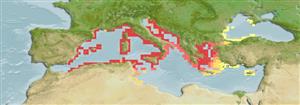>
Blenniiformes (Blennies) >
Blenniidae (Combtooth blennies) > Salariinae
Etymology: Parablennius: Greek, para = the side of + Greek, blennios = mucus (Ref. 45335).
Environment: milieu / climate zone / depth range / distribution range
Ekologi
laut dasar (demersal); kisaran kedalaman 6 - 12 m (Ref. 80021). Subtropical; 47°N - 30°N, 6°W - 42°E
Mediterranean Sea and Black Sea.
Size / Weight / umur
Maturity: Lm ? range ? - ? cm
Max length : 7.0 cm TL jantan/; (Ref. 5981)
deskripsi pendek
Kunci identifiaksi (pengenalan) | Morfologi | Morfometrik
Duri punggung (Keseluruhan (total)) : 12; duri punggung lunak (Keseluruhan (total)) : 18; Duri dubur: 2; Sirip dubur lunak: 19 - 20.
Facultative air-breathing in the genus (Ref. 126274); Adults inhabit dimly lit biotopes like overhanging rocks or caves. Also found in piddock holes. They graze on periphyton (Ref. 5981). Oviparous. Eggs are demersal and adhesive (Ref. 205), and are attached to the substrate via a filamentous, adhesive pad or pedestal (Ref. 94114). Larvae are planktonic, often found in shallow, coastal waters (Ref. 94114).
Oviparous, distinct pairing (Ref. 205). Female deposit eggs inside an empty mussel, male tends the clutch (Ref. 47356). Courtship behavior entails males rearing up front of body (Ref. 5981). Yawning makes for a defense to drive away rivals (Ref. 5981).
Zander, C.D., 1986. Blenniidae. p. 1096-1112. In P.J.P. Whitehead, M.-L. Bauchot, J.-C. Hureau, J. Nielsen and E. Tortonese (eds.) Fishes of the North-eastern Atlantic and the Mediterranean, volume 3. UNESCO, Paris. (Ref. 5981)
Status IUCN Red List (Ref. 130435)
ancaman kepada manusia
Harmless
penggunaan manusia
Alat, peralatan
Warning: mysqli::__construct(): (08004/1040): Too many connections in /var/www/html/includes/speciessummary.lib.php on line 2104
Can't connect to MySQL database fbquizv2. Errorcode: Too many connections
